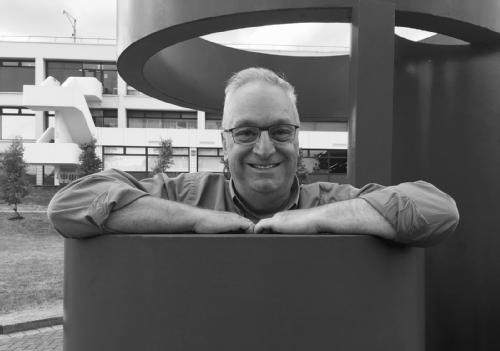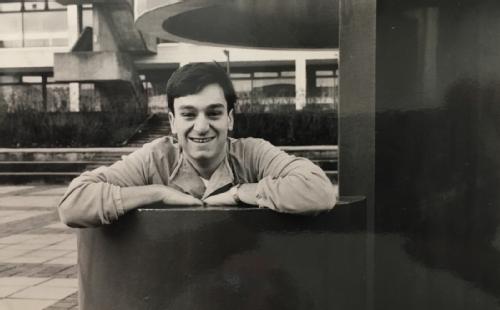Witness Statements
Witness Statement by Lawrence Till - Faith in the Miraculous by Matthew Raw
The magnificent tiles by Matthew Raw which adorn the Faculty of Arts Building (FAB) are perhaps an affectionate response to the early years of the University of Warwick’s campus architecture.
I arrived to study my English & Theatre Studies degree in 1982 when Universities were architecturally in the plate-glass phase. This had followed the red-brick phase and the ancient phase - begun in 1096. However, Warwick at the time was fondly known as a White-Tile University. Concerns following the subsequent frequent shedding of tiles on the Humanities Building transformed it to the White-Metal-Clad University.
Matthew Raw’s strong, bold colours betray the distance we have all travelled since 1965. Faith in the Miraculous, with its echo of ‘Father Forgive’, inscribed in Coventry’s post-war Cathedral, suggests hope and our remarkable ability to proceed with confidence, undaunted by what’s gone before.
The columns of colour and their intricate repeated and unique designs clad the building’s architecture, reflect the imagination, creativity, vividness and delight of what lies within, and invite us all to believe in the possibility of what can be achieved.
Laurence Till
Alumnus, Producer and Director
Witness Statement by Bella Hopper - Resonance by Raymond Antrobus
Raymond Antrobus once said: “becoming a poet publicly moves you [to] pick up conversations with your personal history”. In his villanelle Resonance, he utilises this idea of poetry as conversation to invite the audience into a dialogue about birds.
Within the poem, Antrobus weaves personal experience through his developing relationship to birds, concluding in the penultimate line that he has “finally found a way of living”. Resonance then becomes an active poem in conversation, purposefully stressing the need to “listen” as well as to understand the environment around us.
Between this duality of listening and understanding also lies the core of Antrobus’ poem – a journey of self-discovery by bearing witness to the world in which we live.
Bella Hopper
Undergraduate, Warwick Writing Programme
Witness Statement by Elizabeth Ryder - Resonance by Raymond Antrobus
To resonate is to reverberate, the quality that allows an ephemeral thing, like a sound or a poem, to persist after the initial point of hearing or reading. The sound of the birds singing resonates throughout Antrobus' poem, their ‘difference’ withstanding both the sleet storms and the narrator's attempts to identify and map out their “uncharted astronomy”.
There is a sense in the poem that the phenomenon of the birds can be understood and explained. But the secret lies not in audiobooks about ornithology, but rather in taking off your headphones and listening to their sound.
Writers are like birds. We send out our songs into the world, hoping that they will resonate and maybe teach someone else “a way of living”. The Warwick Writing Department is dedicated to helping developing writers find and cultivate their unique voices. Our community is creative, vibrant and diverse.
Listen. We are the birds, and we sound different in this city.
Elizabeth Ryder
Undergraduate, Warwick Writing Programme
Witness Statement by Paul Grigsby - Carib Guyana Timerhi by Aubrey Williams
Aubrey Williams once noted that ‘Art that is ritualistic, mystical, is profound...Art with no mystery is nothing. It's just decorative.’ There is a lot of mystery in this piece. What are these forms and what do they mean, both to Williams himself and to us, the viewer?
As a Classicist, I want to understand the cultural meanings of the representations here. I imagine I can see interlocking serpentine shapes, a radiating sun disc, a horizon maybe, a map, glyphs, ritual movement. What they really are I have no idea. Williams was interested in the pre-Columbian indigenous cultures of his native Guyana and South America, borrowing their cultural and mythic images for much of his art. The colours he used were traditional colours. This piece borrows elements from the Guyana Carib tribe, but which elements, and of what original meaning, remains a mystery to the viewer. In abstract art just as much as in Classics there is much that remains unknowable and mysterious. That is what draws us to it.
Paul Grigsby
Research Fellow,
Classics and Ancient History Department
Witness Statement by Ana Grujic - Anna Alexeevana, Kich-Gorodok and Antonina, Tatiana and Nastya Ploskovo by Olya Ivanova
Ivanovna’s work glows with trust and an intricate connection between the photographer and the sitters. Her honest approach helps capture the story of Russian women living and working in the forgotten villages without water and electricity, waiting for the better times to come. Abandoned houses and settlements of the former cooperatives are now a mere shadow of the old collective farms. A lonely grandmother remembers working with her family in the grain fields as well as a barn full of cattle – she recalls with melancholy cheerful songs and socializing after a long day. Back then, in post-war Russia, these villages were full of life. However, as the industry developed and agriculture mechanized, former ways of life and work in the countryside have become extinct. These are thus examples of the forgotten individuals, unaware of the passage of time, who are witnesses of a different age. The photographs reveal that women still carry the burden of life with dignity, waiting for the betterment of the 21st century. In this sense, the artist captures the complexity of the Russian soul, the hope and absurd, the pride and sadness and draws us into a different universe.
Ana Grujic
Undergraduate Economics
Ana has been studying Russian for the last 2 years at the Language Centre.
Witness statement by Dr Lydia Plath - Birmingham Race Riot by Andy Warhol
Who is “rioting” here? History asks us to question everything.
In 1963, Martin Luther King, the Southern Christian Leadership Conference and the Alabama Christian Movement for Human Rights organised a protest to desegregate the city of Birmingham. Their strategy was to organise a “Children’s Crusade” to highlight the brutality of white supremacy. It worked: this iconic image of the Civil Rights Movement shows peaceful protestors, many of them Black students, being attacked by police dogs, fire hoses, and batons, and demonstrated the power of nonviolent direct action to expose injustice.
It was during this campaign that King wrote his famous “Letter from Birmingham Jail”, in which he explained that “freedom is never voluntarily given by the oppressor; it must be demanded by the oppressed.” In the age of Black Lives Matter, we are witness to a new era of the Black freedom struggle in which the “white moderate . . . who is more devoted to “order” than to justice”, as King put it, once again decries the methods used by activists to gain their freedom but tolerates the violence of police brutality. Who is rioting, here?
Dr Lydia Plath
Associate Professor, History
Witness statement by Andy Harvey - Paper Maze by Paul Midgley
This an intriguing piece. It’s on quite a scale, so involved the use of many newspapers to create it. I approached it today having forgotten its title, so to find it’s a maze is interesting.
I had wondered if the various swirls and patterns were intended to portray something animalistic or human, and I suppose they still could if the maze represents the whirlwind of human existence. Peter Midgley had quite a tumultuous early life, so perhaps this is ingrained in the many twists and turns in the piece.
The historian in me was keen to see if an exact date could be gleaned from the piece. The perceived assumption is that all the newsprint is from the same time; i.e. 1969. The only date I could see was on the outer frame of the piece and even that says only ‘196_’ with the last digit obscured, but perhaps that was intentional.
The fact that some information can be seen on the outer frame of the piece with everything else being obscured could itself represent the old maxim: Don’t judge a book by its cover.
As with all good art, it raises more questions than answers…
Andy Harvey
Undergraduate History
Witness Statement by Bushra Mahzabeen - Dwelling in this space we breathe by Khadija Saye
The series of portraits draws a sharp balance women have to maintain in their search for peace in spaces that cause them suffocation. The portrait where Khadija places her hands on her eyes or the one where she is unable to speak, symbolises how - in the name of tradition and decorum - creativity and individuality is suppressed in women belonging to a predominantly patriarchal culture. The expressions of faith through the prayer beads would be particularly relevant to any international student, like myself, struggling to stay spiritually rooted and to cope with the demands of the new lifestyle in a foreign country. My initial response of anxiety in viewing the portraits is driven away by the realisation of the infinite human capacity to find hope in times of despair through spirituality and reconnecting with oneself, represented in Saye’s work.
Bushra Mahzabeen
Second Year PhD Student
English and Comparative Literary Studies









